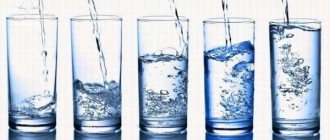Industrial cleaning
Active population growth has directly affected the number of fresh water sources on our planet. As a result, there was a shortage of water, which pushed people to look for various ways to make drinking water “by hand.” The only solution was the possibility of desalination of salty sea water, which is not suitable for drinking.
The World Ocean became the source for desalination. Sea water goes through numerous stages of purification, as a result of which the liquid gets rid of excess amounts of various salts. The use of specialized installations comes to the rescue.
The use of seawater desalinators makes it possible to successfully bring it to a drinking state. Desalination of water on an industrial scale is carried out in different ways. Most of these methods are based on the use of large energy-intensive installations. These are specialized filters and distillers. Let's consider the main types of desalination of water in large volumes.
History of the emergence of the seawater desalination method in the world
Humanity has been thinking about the quality of drinking water since the dawn of civilization. Desalination of water from salt was a necessity for many peoples. In Aristotle's time, sailors boiled seawater and collected the steam with a sponge. Then fresh water suitable for drinking was sucked out of the sponge. In the Middle Ages, the process of obtaining distilled water in a still was described by Leonardo da Vinci. In Russia, the first distillation installation appeared in Krasnovodsk on the shores of the Caspian Sea at the end of the 19th century and could process 67 cubic meters. meters of water per day.
Which countries currently widely use seawater desalination? Today, fresh water shortages are reaching planetary proportions. Developed countries are developing new seawater desalination strategies to minimize the problem of soil aridity and lack of fresh water in coastal saltwater areas. The industrialized USA and Japan have long begun to consume many times more fresh water for domestic and industrial needs than they have in reserve. In the eastern countries of the Arabian Peninsula, where the problem is very acute due to the extreme aridity of the region, desalination complexes based on reverse osmosis have been installed with high productivity - up to 1000 million m3 per year (Saudi Arabia and the UAE). In Israel, the capacity of desalination stations through membrane filtration and distillation of water from the Mediterranean Sea provides the country with 15% drinking water and 50% technical water of the required quantity.
Russia ranks first in the world in terms of fresh water reserves. Only the water area of Lake Baikal is capable of providing all Russians with fresh water today. The problem is that 80% of these reserves are in uninhabited areas of Siberia and the Far East. Extraction and transportation of fresh water to the south-eastern part of the country and to the northern coastal regions will result in high costs. The problem of water desalination is acute in Crimea, Primorsky Krai, the Volga region and the Black Sea coast. The introduction of seawater desalination complexes based on ultrafiltration, reverse osmosis and ion exchange in coastal areas makes it possible to obtain high-quality water for domestic needs. The main issue remains reducing the cost of technology to increase the profitability of water treatment activities.
Cleansing methods
In our world, only a few technologies have been developed that make it possible to convert sea water into running water. One of them is the use of chemical reagents. This method involves the use of special chemical compositions for desalination of liquids. Upon contact with salt water, a reaction occurs that results in the formation of insoluble chemical compounds.
After the reaction is completed, all that remains is to remove the resulting precipitate by filtering. This method is not used in everyday life, and it is extremely rarely used for desalination of water in industry.
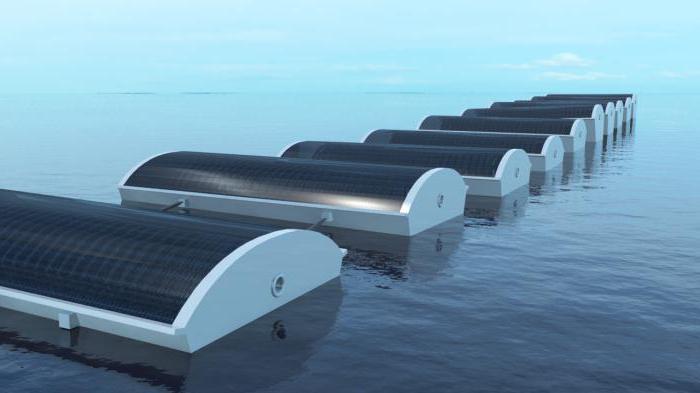
This method has quite significant disadvantages. Firstly, desalination will require a considerable amount of chemicals, secondly, the process takes a long time and, thirdly, it is not cheap.
Desalination of water at home and camping
To convert sea water into fresh water at home, distillation and freezing . Both of these lead to a change in the state of aggregation of water - either its transformation into steam or into ice, as a result of which the water gets rid of a significant part of the salts it contains.
Distillation of water
Distillation involves heating water, further evaporating it and collecting the condensate in a separate container. A moonshine still is best suited for distillation. There are special distillation units that operate at temperatures close to 100 degrees, simultaneously disinfecting it. The disadvantage of distilled water is that it has neither taste nor smell. Drinking it, to put it mildly, is unpleasant. Fortunately, some modern installations have the function of adding mineral water to such water to add at least some taste.
Water condensation
If a moonshine still is not at hand, then you can use the condensation . Tape a water bottle to an empty bottle and place them in the warmest or sunniest location. In this case, the empty bottle should be placed slightly higher than the full one. After a certain time, clean condensate will collect, which will be suitable for drinking.
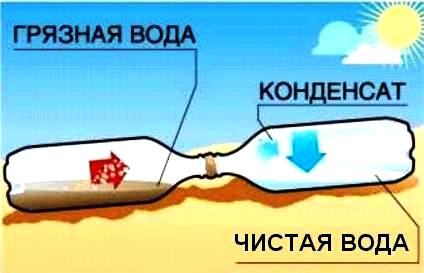
A wide basin will also work for desalination. Water is poured into the basin, and an empty container is placed in its middle. A bag or film is stretched over all this and sealed tightly. A small weight is placed in the middle, and the whole structure is placed in the warmest or sunniest place. After some time, condensation will collect in the container.
Freezing water
Freezing salt water requires a freezer. This method is simple and easy, because it is understandable and does not require the construction of any structures. Simply fill a container with salted water and place it in the freezer. Then, you need to carefully monitor it so that it does not freeze completely. Only the ice on the surface will be fresh water, and if the container freezes entirely, the salt will not go anywhere. Therefore, we monitor the process and collect the ice that forms. The salt will accumulate and therefore there is no need to scoop out all the water from the container. Once you have desalinated two-thirds of the salt water container, pour out the remainder and fill with a new one.
In extreme situations, you will have to improvise, because it is unlikely that anyone will think of taking a portable desalination machine with them on a hike. But the need for invention is tricky, so if you find yourself in a hopeless situation, then use your imagination - you can build an improvised distiller from improvised means, literally from acorns and cones and evaporate the water over an open fire, or use the method with a basin, but instead of a basin use a dug hole.

Reverse osmosis method
This method has long proven itself and is now actively used in industry. It uses special cleaning membranes. They are made of semi-permeable material. For example, from polyamide or cellulose.
Liquid with excess salts is passed through these membranes under a certain pressure. As a result, liquid particles pass through a microscopic mesh, on the surface of which larger particles of various impurities settle. Thanks to this method, it is possible to obtain a fairly large volume of desalinated water.
Operating principle of a seawater desalination plant
A seawater desalinator is a device that allows you to remove salts dissolved in it from a liquid. After this procedure, purified water is obtained. It can be used not only in everyday life, but also as good drinking water.
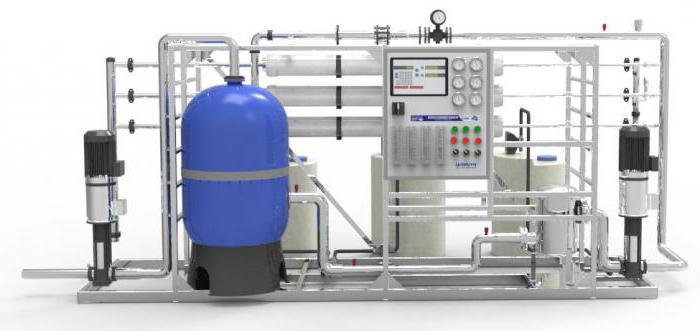
The design feature of the device is convenient and practical in operation. But fresh does not mean clean. After all, in one way or another, different components are preserved. The use of the resulting water directly depends on their density. For example, marine vessels require completely different types of water:
- drinking - exclusively for cooking and drinking;
- water for personal hygiene and deck washing;
- water for steam generators, otherwise it is called nutrient water;
- water for technical purposes (used as a coolant for engines);
- distilled water.
For all these types, different ship-based seawater desalinators are used. All methods are divided into two categories:
- Distillation - a desalination plant that works on the principle of distillation, heats and evaporates sea water. Then the steam is “caught” and brought to the desired temperature.
- Filtration – the principle of reverse osmosis. Salt water is desalinated without changing from one state of aggregation to another.
Its work is based on “leveling” the concentration of dissolved impurities. Extremely high pressure allows you to “squeeze out” unnecessary salt particles.
Desalination methods
When considering the possibility of transforming seawater into its fresh counterpart, one should proceed from the fact that this process is both simple and complex at the same time. Significant funds have been invested in the development of its basic principles for a long time, but positive results were not obtained immediately.
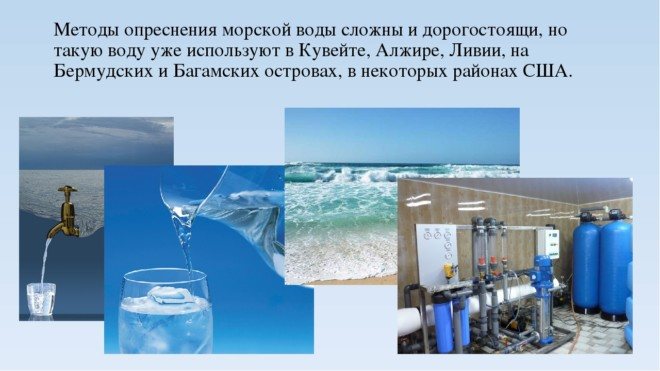
The fact is that its successful implementation on an industrial scale requires huge expenditures of energy resources. Only at the state level has it been possible to achieve relatively good results in obtaining large volumes of fresh water from inexhaustible sea sources.
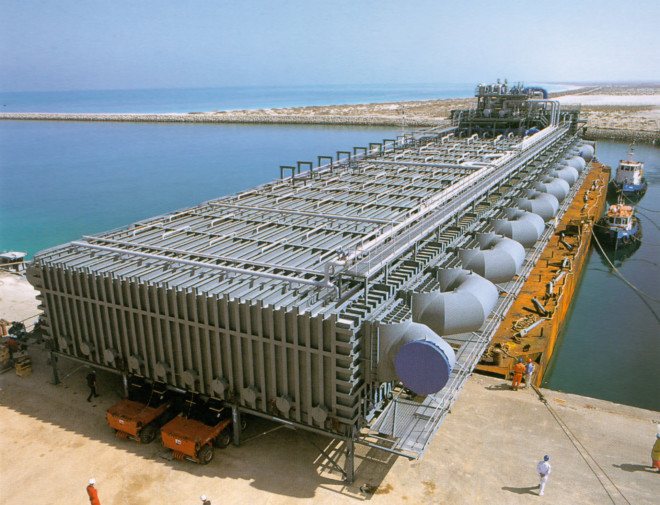
Methods for changing the composition of water used in industrial installations are usually divided into the following types:
- first of all, this is distillation (or simply evaporation);
- then follows desalination by freezing;
- Next comes a process known as “reverse osmosis”;
- Electrodialysis, which is also familiar to many, completes the list.
Interesting fact
The world's largest seawater desalination plant is located in Hadera (Israel). In terms of its scale, this unit resembles almost an entire plant. It desalinates about thirty-three billion gallons of seawater each year.
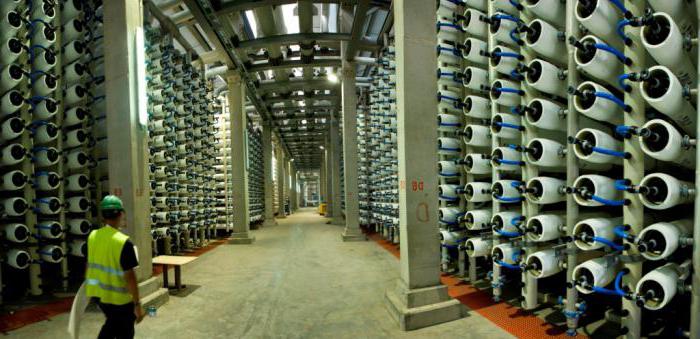
This covers two-thirds of the country’s total needs. After all, as you know, in Israel there is an acute issue of shortage of drinking fluids. This seawater desalinator works, like most all desalination devices, on the principle of reverse osmosis, under the influence of which the waters of the Mediterranean Sea are not subjected to heat treatment.
Solar seawater desalination plant
Recently, unique desalination plants that interact with solar energy have appeared on store shelves. Sea water is poured inside the device, from the received solar heat it turns into steam, condensing on the walls of the case, and settles in the lower part of the receiver.
The design of the installation is completely sealed, it can create a greenhouse effect and does not allow evaporation from outside the desalination plant. Accordingly, as a result of this, more clean water is saved. At the end of this process, simply unscrew the cap and drain the purified water into a container.
What do the researchers suggest?
Research has shown that seawater passed through a filter made of metal-organic frameworks can be converted into fresh water that can be drunk. The filtration process takes only 30 minutes. In addition to salt, the filter also traps other water pollutants.
The technology described in a well-known foreign scientific journal was called revolutionary. Perhaps it can help millions of people around the world have access to safe drinking water. Researchers also believe that the new technology can be useful in mining.
The water obtained by this method can be integrated into existing water systems. This was reported by Professor of the Australian Monash University Huanting Wang.
An eco-bus appeared in St. Petersburg: it has chargers for smartphones
Having seen a chest of drawers while visiting a friend, I wanted one for myself: she said to buy wallpaper
A little warmth: baby photos of animals from a Finnish photographer
Vacuum seawater desalination plant
This type of desalination plant is used in the navy. It utilizes the heat of the liquid that cools the main and auxiliary diesel engines. Clean water, heated to approximately sixty degrees Celsius, enters the inlet through the pipes of the heating battery. At the outlet, the water temperature drops to approximately fifty-five degrees Celsius.
A vacuum desalination plant allows you to obtain about eight hundred liters of distilled water in an hour. This type of desalination plant can cover almost all fresh water needs without unnecessary costs for fuel energy and maintenance. The device is fully automated. Since the evaporation temperature is quite low, the water desalination plant can operate without cleaning for six to twelve months.
Device maintenance
Maintenance of the device should be carried out every week, every month and once a quarter.
An external inspection of the device is required once a week. It is also worth checking the correct operation of pump seals and rarely used valves. Eliminate loose fits and all kinds of leaks at the joints. Once a month, in addition to the weekly inspection, it is necessary to clean the seawater filter mesh, and also lubricate the pump bearings. Once a quarter, the flow meter is checked, and protectors on pipes, brine and pumps are replaced. The spray holes of the evaporator ring tube are cleaned, and the pump stuffing boxes are replaced.
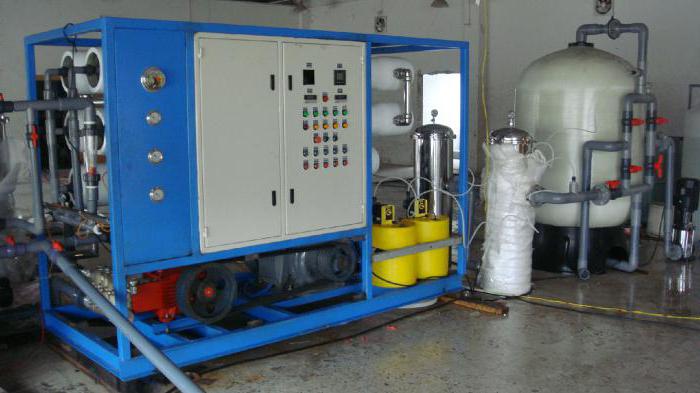
Repair work
The repair process consists of chemical cleaning of the salt water heater and evaporator-condenser, followed by crimping them and rolling up the defective tubes.
You should open the liquid heater, clean the filters from the pipes and the pipes themselves from various debris and accumulated scale. You should also disassemble the flow meter to clean it from dirt and rust. If the pump bearings are worn out, they need to be replaced. Additionally, it is recommended to clean the surfaces of the housings in contact with sea water.
Seawater desalinators for yachts
Having a seawater desalination system on board a small vessel is comfortable and safe. A manual seawater desalinator allows you to save your budget due to the absence of the need to replenish the supply of clean drinking water.
In an average hour, such a desalination plant, designed for small sea vessels, processes hundreds of liters of salt water, turning it into clean drinking water.
Some models of desalinators for yachts have a remote control function, which greatly facilitates control over the process. Such installations are suitable for use on both sailing and motor yachts. Spare parts for ship desalination plants that come into direct contact with seawater are made from substances that are not affected by corrosion. The external structure is most often made of stainless steel.
Where is desalination of sea and used water used?
Water desalination technology in the world is aimed at reducing the salt content of an aqueous solution to concentration limits that establish technical regulations for water consumption in a certain sector of the national economy or industrial production. Depending on the degree of salt removal, a distinction is made between desalting and desalination. During desalting, the concentration of cations and anions is reduced to values corresponding to their content in distilled water. During desalination - to levels that allow the use of water for technical and drinking purposes.
The range of applications of seawater desalination complexes includes almost all areas of human activity:
- Production facilities located on the seashore, where uninterrupted operation requires a constant flow of purified water, including for cooling.
- The agricultural sector uses desalinated water for watering and irrigating agricultural crops, diluting fertilizers, and supplying drinking water to livestock farms.
- Autonomous stations for obtaining fresh water on existing drilling platforms in oceans and seas, where water supply to service personnel from the continent is not possible.
- On long-distance ships and submarines, ship desalination plants are designed to produce water of various qualities: drinking water, household water, technical water for cooling motor equipment, and nutritional water for steam generators.
- Supply of coastal resorts and boarding houses. For example, sanatoriums on the Black Sea coast of Russia and the Crimean Peninsula can fully provide water supply through desalination of sea water.
- Post-purification of brackish water from a well in everyday life and in industry. This is relevant for residents of the sea coast and adjacent regions (Krasnodar Territory, Primorye, Rostov Region, Stavropol Territory, Kuban), where salt water seeps into fresh aquifers.
Portable water purification device
Just recently, scientists announced a new original device created specifically for separating sea water into drinking and salt water. The lion's share of desalination plants operate using reverse osmosis technology, while consuming quite a large amount of electricity. The disadvantages of this desalination method also include the inefficiency of working with small volumes.
A new invention - a portable seawater desalinator based on ion concentration polarization technology. The nano-sized channel is filled with liquid, an electric current is connected, which creates an electric field. Thanks to this, the water is divided into two parallel streams. Salt ions enter one of them, while the other stream contains clean fresh water.
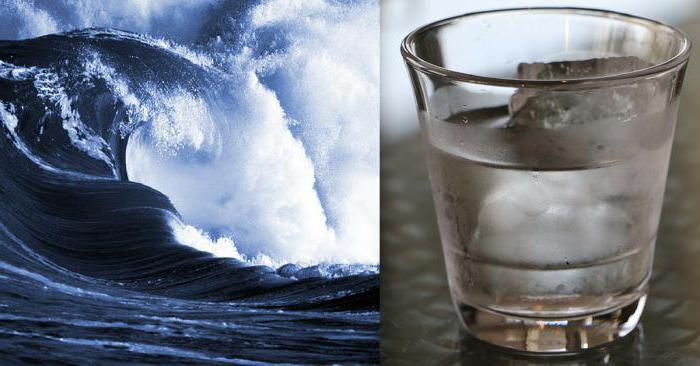
The creators plan to finalize a new device that will be powered by the energy of an alkaline battery. The planned rate of water desalination is about fifteen liters per hour. The invention is promised to be released to the masses in the next two years.
How to make a seawater desalter with your own hands?
Water can be made clean without the use of industrial devices. Making a manual desalination maker is not difficult. To do this, you will need a saucepan with a tight-fitting lid.
This method of water desalination is based on a well-known physical phenomenon - condensation. Pour sea water into the pan, close the lid and boil. The steam accumulated under the lid is pure condensate. All water impurities have a large mass, so they settle to the bottom of the pan, and the H2O particles condense into steam.
This method allows you to desalinate a liquid with a large amount of pure water lost. Therefore, the design should be slightly improved. To do this, you will need to make a small hole in the lid of the pan, insert a flexible hose (tube) into it, and cover the pan with a lid. Direct the other end of the hose into the next pan (any container) and be sure to cover the top with a dampened towel. This will help the steam stay hot.
Put sea water on the fire and boil. We wait until all the water “transfers” to another pan. This will be desalinated drinking water. All salts, as well as various impurities, will remain in the same pan. This simple, homemade seawater desalinator will help you obtain clean drinking water.
Another way to desalinate salt water is to simply freeze it. The fact is that the freezing temperature of sea water and fresh water is somewhat different. Salt water requires a lower temperature to freeze than fresh water to freeze. The resulting ice is desalinated water, which may well be suitable for drinking.
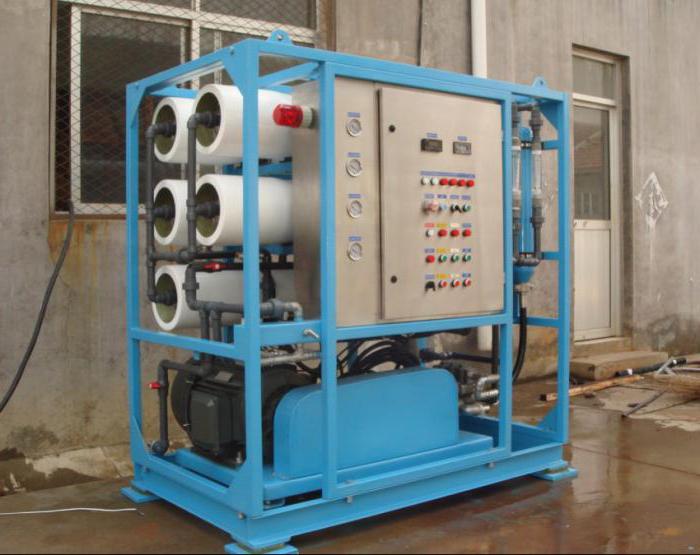
A seawater desalinator is certainly a necessary thing, but only for an industrial scale. At home, you can convert sea water into drinking water using the simple techniques we learned about today. So now you don’t have to worry about the fact that in an emergency, a lack of water can develop into a serious problem.
Desalination methods
When considering the possibility of transforming seawater into its fresh counterpart, one should proceed from the fact that this process is both simple and complex at the same time. Significant funds have been invested in the development of its basic principles for a long time, but positive results were not obtained immediately.
The fact is that its successful implementation on an industrial scale requires huge expenditures of energy resources. Only at the state level has it been possible to achieve relatively good results in obtaining large volumes of fresh water from inexhaustible sea sources.
Methods for changing the composition of water used in industrial installations are usually divided into the following types:
- first of all, this is distillation (or simply evaporation);
- then follows desalination by freezing;
- Next comes a process known as “reverse osmosis”;
- Electrodialysis, which is also familiar to many, completes the list.
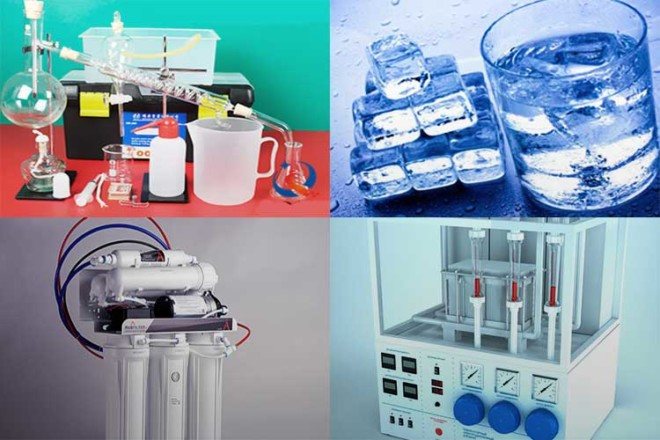
The second method is based on freezing water to a crystalline state, after which its fresh component is separated from the crystals using known technologies. The most popular among all the listed procedures are reverse osmosis purification methods, as well as distillation.




